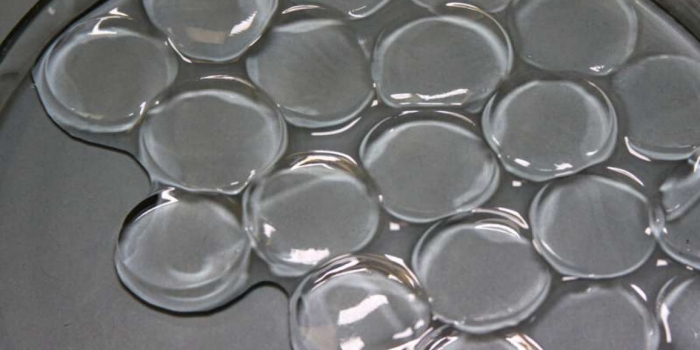Researchers at the Massachusetts Institute of Technology (MIT) have successfully created a superabsorbent material capable of extracting an unprecedented amount of moisture from the air, even in arid environments.
The transparent and elastic nature of the hydrogel, which is commonly found in disposable diapers, allows it to expand as it absorbs water vapor. Even in extremely dry conditions with a relative humidity of 30%, the material can draw vapor from the air and securely retain the moisture without leakage. Once collected, the water can be heated, condensed, and transformed into ultra-pure drinking water.
The MIT team significantly enhanced its absorption capacity by infusing the hydrogel with lithium chloride, a highly effective desiccant. They managed to incorporate more salt into the hydrogel compared to previous studies, enabling it to absorb and retain an exceptional amount of moisture across various humidity levels, including extremely dry conditions where other materials fall short.

The potential applications of this superabsorbent gel are vast. If produced rapidly and on a large scale, it could be deployed as a passive water harvester, particularly in desert regions and areas prone to drought. The material would continually extract vapor from the air, which could then be condensed into drinking water. Additionally, the researchers envision incorporating the gel into air conditioning units to improve energy efficiency and act as a dehumidifying element.
Carlos Díaz-Marin, a mechanical engineering graduate student and MIT’s Device Research Lab member, expressed their excitement about the material’s versatility and potential impact. While the team has focused on exploring the material’s fundamental properties, they are now exploring applications such as water harvesting and enhancing air conditioning efficiency. Díaz-Marin emphasized the material’s low cost and high performance, underscoring its significant potential.
MIT’s Device Research Lab is dedicated to developing innovative materials to address global energy and water challenges. In their quest to find materials capable of harvesting water from the atmosphere, the team focused on hydrogels—a slippery, stretchy gel composed mostly of water and a small amount of cross-linked polymer. Hydrogels have been used as absorbent materials in diapers for their ability to swell and retain significant amounts of water upon contact.
The researchers sought to harness the same water-absorption properties of hydrogels to capture vapor from the air. Through extensive literature research, they discovered that mixing hydrogels with various salts had been previously explored. Certain salts, such as rock salt used for melting ice, exhibit exceptional moisture-absorbing capabilities, including water vapor. Among them, lithium chloride stood out as a salt capable of absorbing more than ten times its own mass in moisture. However, using lithium chloride alone would result in absorbed moisture pooling around the salt, unable to be retained.
To address this challenge, the MIT team infused the salt into hydrogel, creating a material that could both retain moisture and expand to accommodate additional water. They achieved a remarkable synergy by combining the unique properties of hydrogel and lithium chloride.

Previous attempts by other researchers had reached a limit in the amount of salt that could be loaded into the hydrogel. The most successful samples recorded salt infusions of 4 to 6 grams per gram of polymer, absorbing approximately 1.5 grams of vapor per gram of material at 30% relative humidity in dry conditions.
The MIT team pursued an alternative approach, allowing the material synthesis to proceed for longer periods. They immersed hydrogel tubes into lithium chloride solutions with varying concentrations, weighing the resulting disks daily to measure salt infusion. The extended experiment duration yielded promising results, as the hydrogels incorporated up to 24 grams of salt per gram of polymer, surpassing previous records.
The researchers subjected the salt-infused gels to absorption tests at different humidity levels and observed their ability to swell and absorb moisture without any leakage. Notably, the gels demonstrated a “record-breaking” capacity to capture 1.79 grams of water per gram of material in extremely dry conditions with 30% relative humidity.
The team’s next focus is on enhancing the kinetics of the material, aiming to accelerate its superabsorbent properties. They aim to achieve rapid water uptake, enabling multiple water harvesting cycles throughout the day instead of just once. The ultimate goal is to harness the potential of this material to generate water in deserts and address pressing global water challenges.
The research breakthrough holds promise for advancing water sustainability efforts and providing a reliable source of pure water in areas affected by water scarcity.
The study is published in Advanced Materials.


